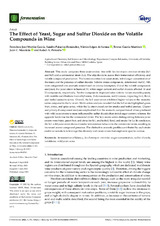The effect of yeast, sugar and sulfur dioxide on the volatile compounds in wine
Autor
Martín-García, Francisco José
Palacios-Fernández, Sandra
López de Lerma, Nieves
García-Martínez, Teresa
Mauricio, Juan C.
Peinado, Rafael A.
Editor
MDPIFecha
2023Materia
Fermentation efficiencySaccharomyces cerevisiae
Sugar concentration
Sulfur dioxide
Volatilome
Wild yeast
Wine
METS:
Mostrar el registro METSPREMIS:
Mostrar el registro PREMISMetadatos
Mostrar el registro completo del ítemResumen
This study compares three yeast strains: two wild Saccharomyces cerevisiae strains (Sc1 and Sc5) and a commercial strain (Lc). The objective is to assess their fermentation efficiency and volatile compound production. The factors examined are yeast strain, initial sugar concentration of the must, and the presence of sulfur dioxide. Volatile aroma compounds, determined via GC–MS, were categorized into aromatic series based on aroma descriptors. Out of the volatile compounds analyzed, the yeast strain influenced 39, while sugar content and sulfur dioxide affected 16 and 23 compounds, respectively. Twelve compounds displayed odor activity values exceeding unity, with notable contributions from ethyl esters, β-damascenone, and β-ionone, impacting fruit, floral, and herbal aromatic series. Overall, the Sc1 yeast strain exhibited higher values in the aromatic series compared to the Lc strain. Multivariate analysis revealed that the Sc1 strain highlighted green fruit, citrus, and spice series, while the Lc strain stood out for smoky and herbal aromas. Cluster and principal component analyses emphasized that the aromatic composition of wines produced with wild yeast strains is more influenced by sulfur dioxide than initial sugar content, whereas the opposite holds true for the commercial strain. The key aroma series distinguishing between yeast strains were fruity, green fruit, and citrus for Sc1, and herbal, floral, and smoky for Lc. In conclusion, the Sc1 wild yeast strain showed similar fermentation behavior to the commercial strain, resulting in increased aroma compound presence. The distinctive aromatic profiles contributed by each strain enable winemakers to leverage this diversity and create wines that emphasize specific aromas.

